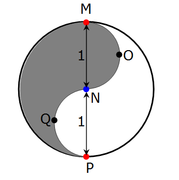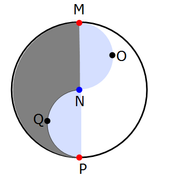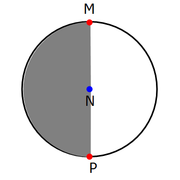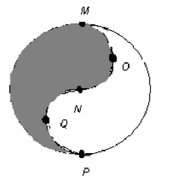Hello,
Can you please assist with this:
In the figure above, if the area of the circle with center N has area pi, and
MNP is a diameter of the circle, what is the area of the shaded region?
(1) MON and NQP are semi-circles.
(2) The shaded area equals the unshaded area.
OA: D
I started as follows:
Area of circle = pi
=> pi r^2 = pi
=> r^2 = 1
=> r = 1
1) Area of semi circle MON = pi (1/2)^2 = pi(1/4)
However, I was not sure how to proceed from here.
Area of shaded region of circle
This topic has expert replies
-
gmattesttaker2
- Legendary Member
- Posts: 641
- Joined: Tue Feb 14, 2012 3:52 pm
- Thanked: 11 times
- Followed by:8 members
GMAT/MBA Expert
- Brent@GMATPrepNow
- GMAT Instructor
- Posts: 16207
- Joined: Mon Dec 08, 2008 6:26 pm
- Location: Vancouver, BC
- Thanked: 5254 times
- Followed by:1268 members
- GMAT Score:770
Target question: What is the area of the shaded region?
Given: N is the center of the circle. The circle has area pi. MNP is a diameter of the circle.
Area = (pi)r²
So, if the area of this circle is pi, we get: pi = (pi)r², which means r = 1
So, let's add this to our diagram.

NOTE: At this point, we might conclude that we already have enough information to determine the area of the shaded region, but we really don't know anything about the shapes MON and NQP. They COULD be semicircles or the COULD be something else, like differently-shaped ellipses.
Statement 1: MON and NQP are semi-circles.
At this point, we COULD determine the areas of MON and NQP, but we don't have to.
Just recognize that MON and NQP (the blue areas below) must have the same areas since they're both semicircles with the same radii.

So, we could just take the shaded region MON and use it to fill the gap created by NQP to get the following:

At this point, we can see that the shaded region takes up HALF the space of the entire circle.
Since we already know the ENTIRE circle has area pi, the shaded portion must have area pi/2
Since we can answer the target question with certainty, statement 1 is SUFFICIENT
Statement 2: The shaded area equals the unshaded area.
In other words, the shaded region takes up HALF the space of the entire circle.
Since we already know the ENTIRE circle has area pi, the shaded portion must have area pi/2
Since we can answer the target question with certainty, statement 2 is SUFFICIENT
Answer = D
Cheers,
Brent
-
gmattesttaker2
- Legendary Member
- Posts: 641
- Joined: Tue Feb 14, 2012 3:52 pm
- Thanked: 11 times
- Followed by:8 members
Hello Brent,Brent@GMATPrepNow wrote:Target question: What is the area of the shaded region?
Given: N is the center of the circle. The circle has area pi. MNP is a diameter of the circle.
Area = (pi)r²
So, if the area of this circle is pi, we get: pi = (pi)r², which means r = 1
So, let's add this to our diagram.
NOTE: At this point, we might conclude that we already have enough information to determine the area of the shaded region, but we really don't know anything about the shapes MON and NQP. They COULD be semicircles or the COULD be something else, like differently-shaped ellipses.
Statement 1: MON and NQP are semi-circles.
At this point, we COULD determine the areas of MON and NQP, but we don't have to.
Just recognize that MON and NQP (the blue areas below) must have the same areas since they're both semicircles with the same radii.
So, we could just take the shaded region MON and use it to fill the gap created by NQP to get the following:
At this point, we can see that the shaded region takes up HALF the space of the entire circle.
Since we already know the ENTIRE circle has area pi, the shaded portion must have area pi/2
Since we can answer the target question with certainty, statement 1 is SUFFICIENT
Statement 2: The shaded area equals the unshaded area.
In other words, the shaded region takes up HALF the space of the entire circle.
Since we already know the ENTIRE circle has area pi, the shaded portion must have area pi/2
Since we can answer the target question with certainty, statement 2 is SUFFICIENT
Answer = D
Cheers,
Brent
Thank you very much for your excellent explanation (and for the superb visuals as well.)
Best Regards,
Sri





















